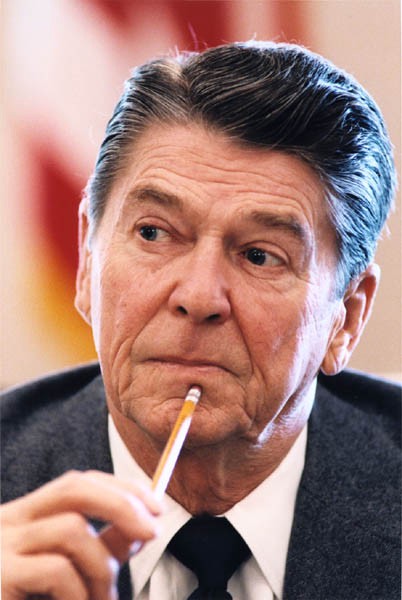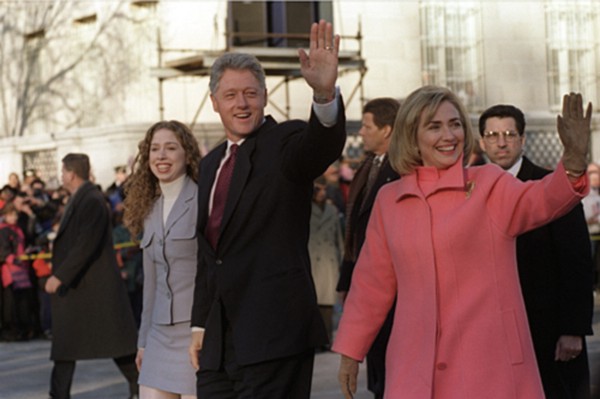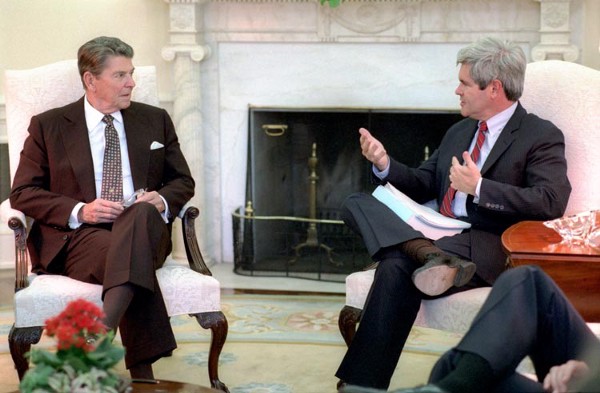Reagan’s revolution and Clinton’s liberal reinvention
By John Moretta
This is Part Two of a three-part series on the 2016 GOP victory in historical context by professor and author John Moretta, whose book The Hippies is out now with McFarland Press.
---
Although elected with sizable conservative support, Nixon proved a major disappointment to many of his right-wing hopefuls. The attempted Watergate cover-up and scandal, which forced him to resign from office, discomfited many conservatives — yet not as much as Nixon’s failure to destroy the liberal domestic policies of his Democratic predecessors. In many instances Nixon expanded those initiatives, believing there was nothing philosophically wrong with many of them — they just needed to be better managed.
As Jonathan Schell observed, “The idea that a team of bright, efficient administrators was coming in to clean up a mess left by wooly-headed idealists and impractical philosophers was reinforced by a dizzying whirlwind of ‘reorganization,’ or ‘structuring’ which soon got under way in the White House. For each national problem, it seemed, the White House had an administrative answer.”
Indeed, Nixon never questioned the existence of big government nor the efficacy of federal activism to improve Americans’ quality of life. Moreover, Nixon simply lacked interest in domestic policy, let alone the desire to mount a full-scale assault on liberal political economy. Nixon held foreign policy to be his forte, the arena in which he could not only achieve the greatest good for his fellow citizens, but personal acclaim as well. By focusing on the administration of domestic policy rather than the substance of such initiatives, Nixon created the illusion that he was eradicating his predecessors’ liberal programs when in reality he was continuing and expanding them. It was artful politics, disarming his conservative critics while maintaining the flow of funds to program beneficiaries. As Daniel Patrick Moynihan, Nixon’s right-hand man on domestic issues, noted, “Richard Nixon most opted for liberal policies, merely clothing them in conservative rhetoric.”
The Dark, Dark Hours
Conservatives had to wait for the 1980 election of Ronald Reagan to put in motion the practical demise of the liberal ethos. Reagan campaigned as a Nixon-Wallace fusion — veiled race baiting, references to states’ rights, lambasting “welfare queens” and “young bucks” who bought steaks with food stamps. Yet once in office (especially in his second term), Reagan abandoned much of his hard-right posturing as he realized that some cornerstones of liberal political economy — Social Security, Medicare, and Medicaid — were inviolable programs.

Photo from Martin Magberg
To the chagrin of the right-wingers who supported him as a Washington outsider and conservative radical riding into town as the new sheriff to clean up the mess left behind by his liberal predecessors, Reagan quickly morphed into an Establishment Republican, willing to accept the fundamental tenets of positive government. Helping Reagan to that realization was a Democratic-controlled House and his closest advisors, the majority of whom came from the moderate, internationalist wing of the Republican Party and who impressed upon Reagan that any tampering with core entitlements would cause a massive Democratic and public rebuke. Thus, for another eight years, the core components of liberal political economy remained intact, even if Reagan became apotheosized as a conservative hero by the end of his two terms and the South was now firmly GOP territory. The liberal pillars of social welfare would stand through both Bush administrations, despite a failed attempt during George W’s second term to privatize Social Security.
Ultimately, although Reagan and the Bushes were able to contain and use the far-right reactiveness within the Republican Party during their respective times in office, they and their down-ballot Republicans continued to stoke that fire to win elections, increasingly at the local level, and momentum was on the side of the far right. It would only be a matter of time before the various coalitions that comprised that faction would ascend to become the guiding force of the party’s mainstream.
The Democrats Lose Heart — and the Country
Although reactionary forces had been trying to gain control of the Republican Party since 1968, they might not have been successful had the Democratic Party not moved to the center — and even to the right on certain socioeconomic issues. During the 1990s, the Democrats attempted to recapture both the White House and the middle class, euphemistically referred to as “the Reagan Democrats”: those blue- and white-collar disillusioned Democrats who, for a variety of socioeconomic and cultural reasons, had gravitated to the Republican Party in the years since Nixon’s first election.
To many doleful Democrats, the loss of their white, blue-collar, middle-class constituencies appeared permanent after their humiliating defeat in the 1984 presidential election, which saw Reagan win a second term by a landslide. Indeed Reagan’s 1984 victory stands as one of the greatest, most complete thumping of an opposition candidate in the history of the Republic, despite Donald Trump’s delusional assertion that such acclaim belongs to him. As a result of the Reagan thrashing, the Democratic Party found itself in ideological disarray. Emerging out of the abyss came Al From, who formed the Democratic Leadership Council (DLC) in 1985 along with a host of other post-Great Society Democrats. Through the DLC, he helped craft the centrist New Democracy movement, essentially what people called neoliberalism. They believed the party would have to tack to the middle if it hoped for future electoral success at all levels of government. (History has shown this to have had dubious results).
In short, the neoliberals claimed that the party had no choice but to center itself and cultivate a new relationship with capital and a fresh appeal among the middle class, especially with its more upwardly mobile, affluent members (who had moved to the right under Reagan). It was time for the party to shed its New Deal/Great Society heritage and shibboleths, and instead embrace a new look that reflected the interests and concerns of what essentially amounted to the white middle class — although none of them would have phrased it as such. And joining this DLC-designed ideology were Bill and Hillary Clinton, the former becoming the neoliberal movement’s most ardent and articulate champion.
Clinton and his neoliberal comrades had to convince middle class moderates that the party would not become the captive of special interests (code for disenfranchised minorities) or engage in interest-group liberalism. To many middle-class Democratic “expatriates,” it was the favoritism bestowed on such groups by 1960s liberals that had caused such widespread outrage, leading not only to liberal excesses but the party’s demise at the national level as well. At the same time, neoliberals still had to wrap themselves gingerly in the New Deal/Great Society mantle so that traditional liberals and people of color people wouldn’t rebel against the party’s forsaking of its progressive heritage and advocacy for marginalized populations.
However, it was with middle-class Americans that neoliberals wanted their message to resonate: a class the Reagan revolution ignored and victimized in all but the rhetorical as the era (the 1980s and early 1990s) witnessed a doubling of income and wealth for the top one percent of the country. As the Democrats now saw it, the middle class was the voting bloc whose values and attitudes had to be embraced and reflected in party ideology and rhetoric, and whose well-being had to be championed above all other interests.
Thus, in the neoliberal litany, “fairness” meant respecting the hard work and ideals of middle-class America, getting able-bodied people off welfare, and assuring that everyone — but especially the well-off — paid their fair share of taxes. (Fair share could take on more than one meaning, however, especially when it came to the wealthy.)

The neoliberal economic frame of reference was premised on investment, accountability, and shared responsibility. Rarely, if ever, in speeches before middle-class audiences did neoliberals call for expansion of the welfare state or greater government intervention in the private sector. Indeed, neoliberals believed (until the 2008 Wall Street collapse) that the most dangerous features of corporate and financial capitalism had been eliminated by their predecessors and emphasis on economic growth was the surest route to social progress while consumption (rather than production) guaranteed sustained economic expansion.
In pursuit of full employment, the government would not implement corporate regulatory policies, nor would it try to redistribute economic power and limit inequality. Rather, the government would maintain a compensatory welfare system (“safety nets”) for those whom capitalism had failed. In effect, the neoliberals detached liberalism from its previous emphasis on reform, its emphasis on issues of class, race, and poverty, and its hostility to concentrated economic power. For neoliberals, the government’s economic policies should be focused on helping the private sector create jobs, for when there are jobs aplenty, everyone is able to improve their lot.
Or in other words, the Democrats themselves helped kill the New Deal and the Great Society.
Bill Clinton and the Triangle Offense
The neoliberal strategy paid off in 1992 with the narrow election of their stalwart Bill Clinton, and it was reaffirmed by his overwhelming reelection in 1996, after which he promised to enact even more neoliberal policies, including some disastrous financial deregulation initiatives, such as the repeal of the Glass-Steagall Act in 1999.
Since 1933, Glass-Steagall had restrained the banking industry and protected consumers from the avarice and capriciousness that Wall Street — and even Main Street — bankers all too frequently engaged in. No surprise to anyone in 2017, the Clinton repeal of Glass-Steagall contributed significantly to the 2008 financial crisis.
Clinton also enacted harsher welfare cuts, more aggressive policing policies, and broader trade integration agreements.
(Many of these neoliberal policies came back to haunt Hillary Clinton during the 2016 campaign, as both Trump (from the right) and Bernie Sanders (from the left) criticized her for having supported and then as senator furthering such initiatives. Sanders’s popularity in particular forced Hillary Clinton to move to the left on the issues of regulation, trade, policing, and social welfare.)
Bill Clinton brilliantly held together the traditional liberal coalition by embracing and celebrating multiculturalism, welcoming into the party new ethnic groups while continuing to respect the membership of older coalition members. It was a triangulation of interests: appeal to the loyal liberal and minority base with multiculturalist rhetoric while enacting policies to win back the centrist white middle-class.
Since the 1990s, neoliberals have continued to assert that diversity was a positive development, enriching and strengthening the American character by endowing citizens with a more global perspective and tolerance. Neoliberals lambaste those Republicans who continue to see the existence of multiple cultures as negative and un-American — the message conveyed by its far-right members, who, along with other reactionaries, xenophobes, and bigots, coalesced to ignite the “culture wars” of the 1990s. It’s a large reason why the right continued to despise the Clintons in spite of their centrist — and sometimes even right-wing — policy-making.
Contracting America
Inthe 1994 midterm elections, Americans got a brief glimpse of what could become a permanent reality during a Trump presidency. In the Congressional elections of that year, the Republicans swept to power in both houses. Soon after taking control, the new House Speaker, the hardcore conservative Newt Gingrich of Georgia, led the Republican Congressional counterrevolution against the Clinton administration’s proposed health care policy and other entitlement spending. The Republican victory prompted one Democratic Leadership Conference member to declare that “The New Deal is over . . . The nails are in the coffin . . . New Deal liberalism is dead and buried.” As another Democrat observed in the election’s aftermath, “The Republicans enjoyed a double triumph, killing reform and then watching jurors — the American people — find the president guilty. It was the political equivalent of the perfect crime.”
Appropriately, Gingrich’s headquarters on midterm election night was “filled with vengeful glee,” according to The New York Times. Texas Senator Phil Gramm declared that it was his intention to “blow this train [the Clinton presidency] up.”
The Gingrich-inspired “Contract With America” consisted of ten objectives, but the most immediate and urgent were cutting taxes, passing a balanced budget amendment, and reducing the “bloated” government bureaucracy with radical welfare reform — in short, to begin the actual dismantling of liberalism, even the tepid neoliberalism of the Clinton administration.
Declaring the Democrats to be “the enemy of normal Americans,” Gingrich and his right-wing Republican allies defined the election as a referendum on big government.

From his position as House Speaker, Gingrich sought to whip his minions into a phalanx of united, disciplined zealots committed to enacting their own anti-Rooseveltian Hundred Days of reactionary policies aimed at the reversal of 60 years of positive government. One after another, bills were brought to the floor for votes. There were no hearings and legislators often didn’t even know what they were voting on. President Clinton, of course, became the object of ridicule: an emasculated, irrelevant bystander, watching an unstoppable juggernaut tear to pieces not only his agenda but the last vestiges of actual liberalism as well.
The counterrevolution appeared triumphant. “We are finally seeing where [the Republican contract] has been carrying us,” noted The New York Times. “Dr. Kevorkian is now waiting in the parlor. He’s about to be shown upstairs to finish off the government we have known for sixty years.”
Although the Republicans had accused Clinton of hubris, Gingrich and his cohort were exhibiting peak arrogance as they slashed and burned their way across the liberal landscape, never stopping to think that perhaps they were pushing too hard and that not even their voters might be behind their counterrevolution 100 percent. They ignored the reluctance of the American people often to take radical leaps without adequate discussion and negotiation. As the moderate Republican Bob Dole observed at the time, “There’s a way to use power when you get it and my view was that maybe they’ve just been a little too much in a hurry. You don’t undo 40 years, 20 years, or 30 years in 100 days or even four years.” Moreover, pundit Russell Baker asked what was “the end game? Do the designers of the post-government age know what they’re doing? In a matter of days they have been dismantling and redesigning structures that took years to put up. Who really has the vaguest idea what the results will be? Best bet: Nobody.”
The Republican Counterrevolution Eats its Own
Within a few months of what appeared to be the end of liberalism, the American people began to question the wisdom of Gingrich, et al. Were there not some government programs worth preserving, even expanding, such as those protecting the environment? Equally alarming to many Americans was the fact that a high percentage of new Republicans had no prior elective experience and had won simply because of their ideological connection to groups like Ralph Reed’s Christian Coalition or other conservative organizations. As a result, increasing numbers of Americans began to question whether the individuals they just elected were acting in their best interests.
Many Americans were dismayed to find that too many of the new Republicans were nothing more than the lackeys of extreme right special interest groups, so obsessed with vilifying Clinton and destroying the welfare state that they arrogantly disregarded their constituents’ wishes. By September 1995, less than a year after their supposed mandate, the conservatives found themselves on the run as 58 percent of the American people disapproved of the job Congress was doing.
However, it was with middle-class Americans that neoliberals wanted their message to resonate: a class the Reagan revolution ignored and victimized in all but the rhetorical as the era (the 1980s and early 1990s) witnessed a doubling of income and wealth for the top one percent of the country.
Clinton countered by doubling down on his agenda of making the Democrats the party of the middle class, who neoliberals were confident still believed in positive government as long as the reform initiatives were focused, limited, and specific — and especially if they could be enacted in conjunction with the private sector (to help hold down costs and reduce the deficit). In his January 1996 State of the Union address, Clinton announced before a stunned audience that “The era of big government is over.” And with that one pronouncement, he not only finished off the Republican counterrevolution of 1994 but also guaranteed his reelection.
Clinton reaffirmed his 1992 pledge that he was a new Democrat with fresh ideas, especially a willingness to take a hard look at the excesses of big government, whatever that meant to people. Most importantly, Clinton’s declaration confirmed that the Democratic Party had at last shed its New Deal and Great Society shibboleths. In its place had emerged a new party devoted to the interests and concerns of middle class America. Neoliberalism had triumphed over Rooseveltian and Johnsonian political economy.
The Democratic Party and its rank and file have remained loyal to that ethos, convinced by Barack Obama’s two terms in the White House that there should be no turning back or no need to rethink the wisdom of that turn.
- Originally appeared at Thepoleax.com

